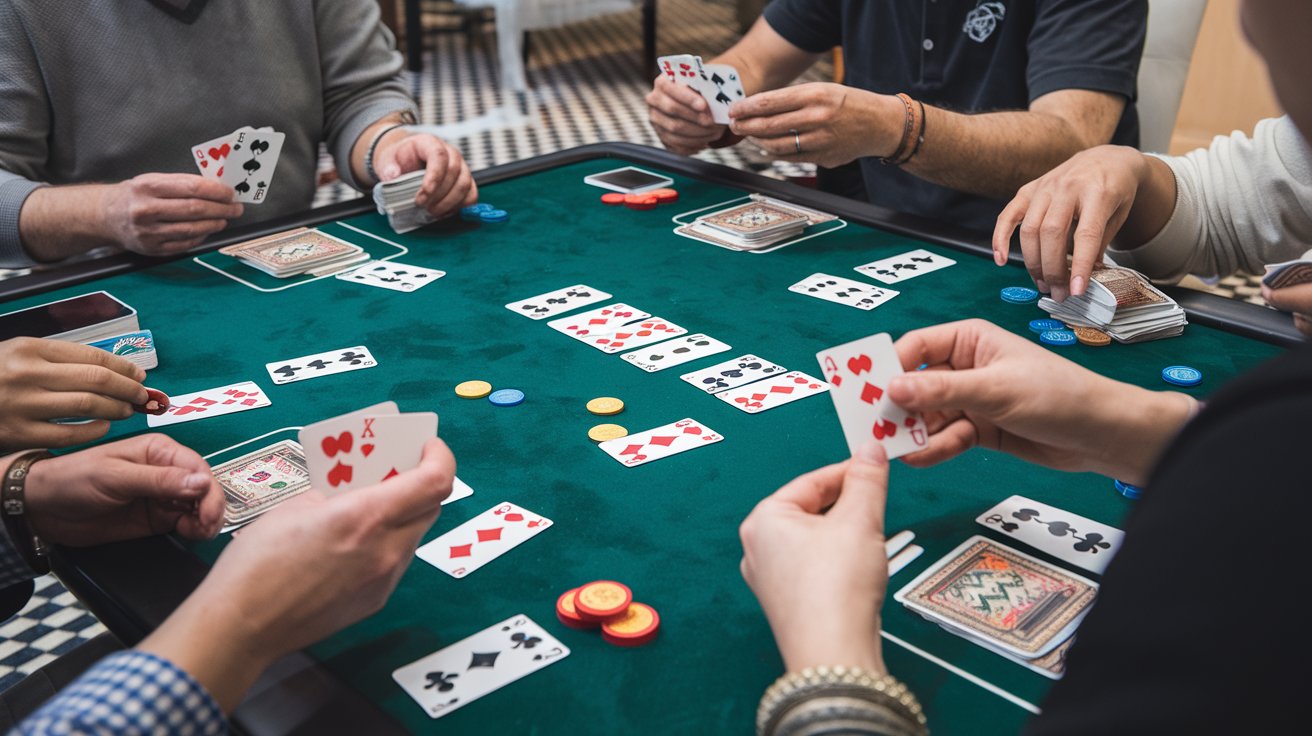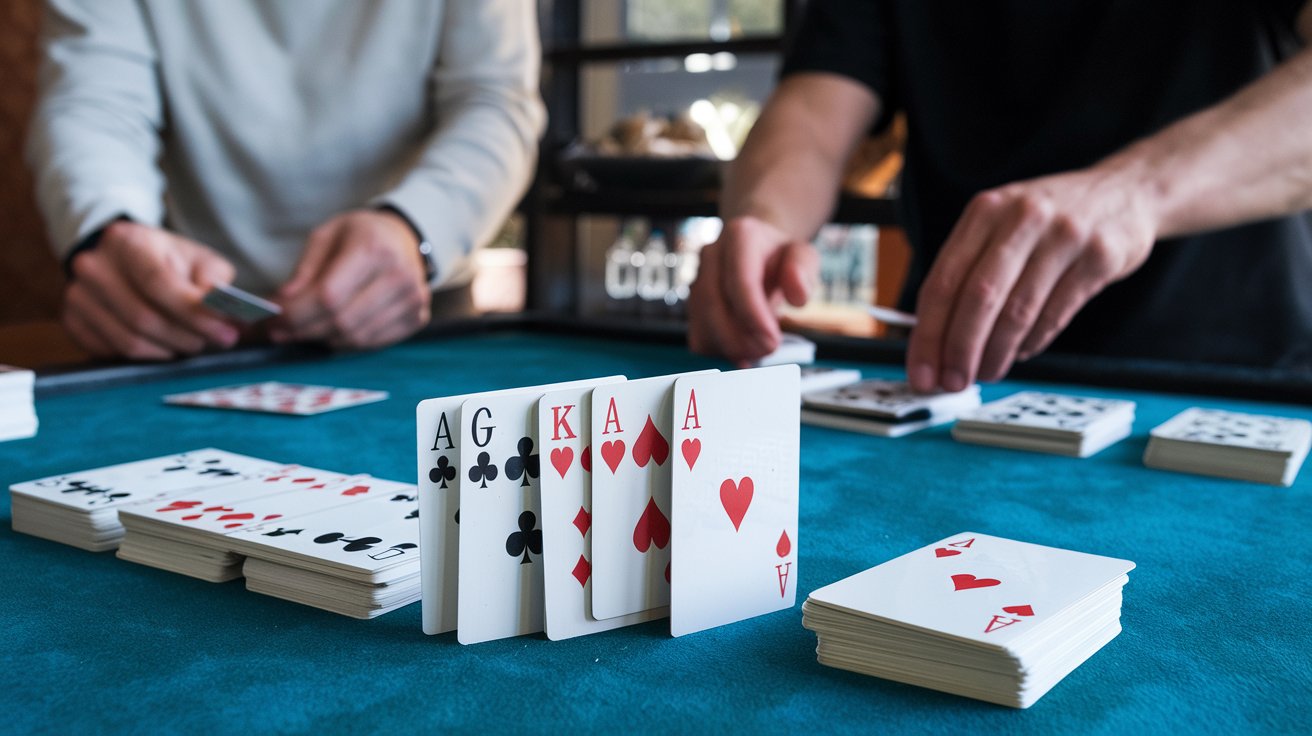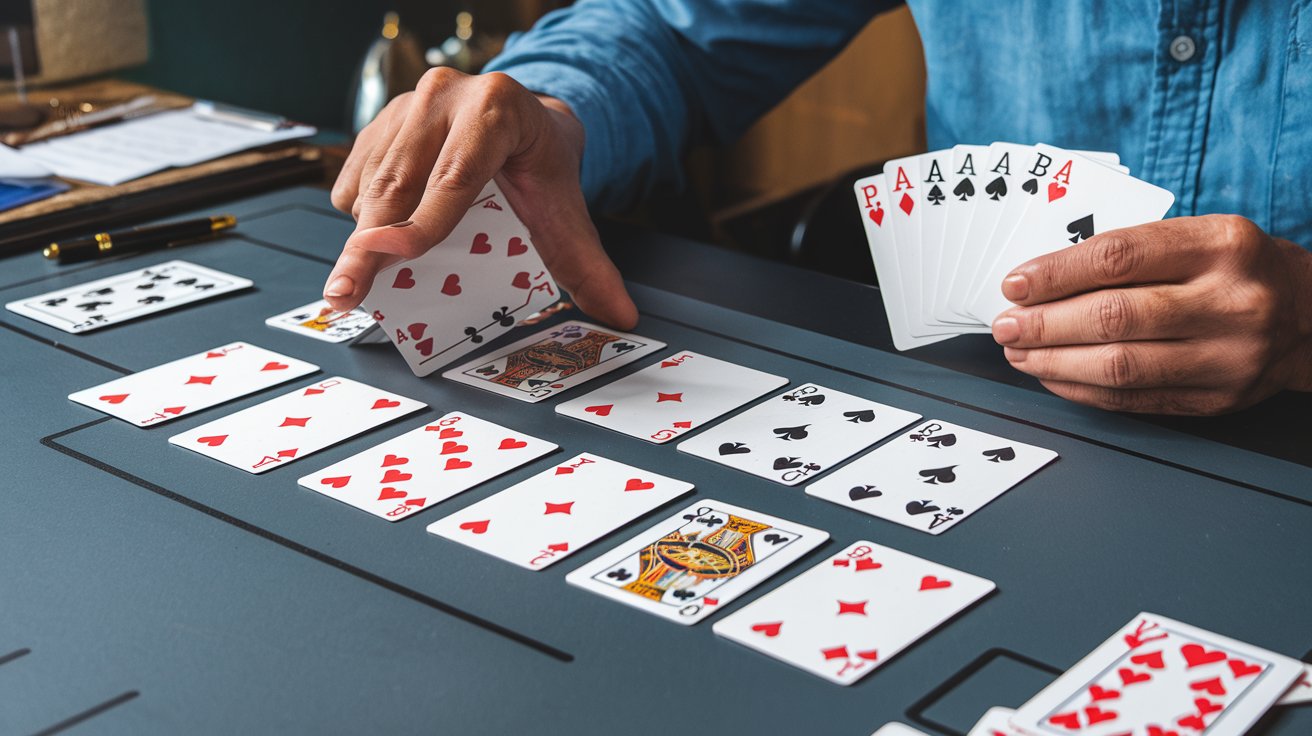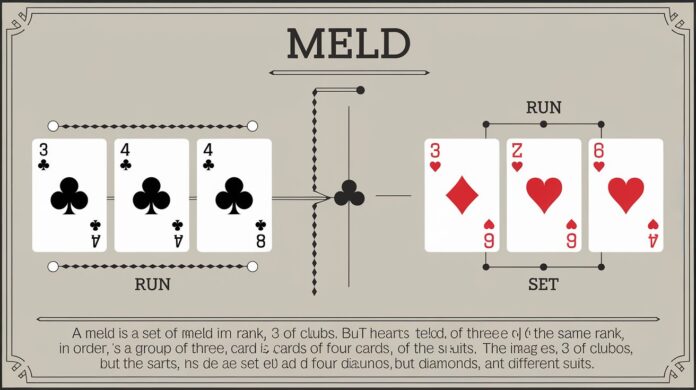If you’re new to the world of rummy card games, you’ve probably come across the term “meld” and wondered what exactly it means. Melds are fundamental to rummy gameplay—they’re the very building blocks that determine whether you win or lose. In this comprehensive guide, we’ll break down everything you need to know about melds in rummy, from basic definitions to strategic considerations, all explained in beginner-friendly terms.
Understanding the Basics: What Is a Meld?

A meld is simply a valid combination of cards that players form during a rummy game. These combinations follow specific patterns and rules, and creating them is the primary objective in all rummy variants. Think of melds as the “goals” you’re trying to score in the game of rummy.
In its simplest form, a meld consists of three or more cards arranged in one of two specific patterns:
- Sets (also called “groups” or “books”): Three or four cards of the same rank but different suits.
- Runs (also called “sequences”): Three or more consecutive cards of the same suit.
Let’s look at each type in more detail.
Types of Melds in Rummy
Sets: Matching Ranks Across Different Suits
A set consists of cards of identical rank (number or face value) but from different suits. Valid sets must contain at least three cards and no more than four cards (since a standard deck only has four suits).
Examples of valid sets:
- Three 7s: 7♥, 7♦, 7♣
- Four Queens: Q♥, Q♦, Q♣, Q♠
- Three Aces: A♥, A♦, A♠
Important rules about sets:
- Each card in a set must be of the same rank
- Each card must be from a different suit
- Duplicate cards are not allowed (e.g., you cannot have 7♥, 7♥, 7♦)
- Most rummy variations require a minimum of three cards to form a valid set
Runs: Consecutive Cards of the Same Suit
A run consists of three or more cards in sequential order, all belonging to the same suit. The sequence must be unbroken, meaning there can be no gaps between the ranks of the cards.
Examples of valid runs:
- 4♥, 5♥, 6♥
- 8♣, 9♣, 10♣, J♣
- Q♠, K♠, A♠ (in some variations)
Important rules about runs:
- All cards must be of the same suit
- Cards must be in consecutive order
- Typically require a minimum of three cards
- The sequence of Ace, King, Queen varies by game version (more on this below)
Special Considerations for Melds

The Role of Aces
The positioning of Aces in runs can vary depending on the rummy variation you’re playing:
- Low Ace: In some versions, Ace is only counted as “1” and can only be used at the beginning of a low run (A♥, 2♥, 3♥).
- High Ace: In other versions, Ace is counted as higher than King, allowing for runs like Q♠, K♠, A♠.
- Both High and Low: Many modern rummy variations allow Aces to be used as either high or low, but not both simultaneously in the same game.
Always clarify which rule applies before starting a game, as this significantly impacts your strategy.
Wild Cards and Jokers
Many rummy variations incorporate wild cards or jokers that can substitute for any card needed to complete a meld:
- Jokers: Physical joker cards included in the deck
- Wild cards: A randomly selected card that acts as a joker for that particular game
When using wild cards or jokers in melds, special rules often apply:
- Some games limit how many wild cards can be used in a single meld
- Others require at least one natural (non-wild) card in each meld
- In Indian Rummy, at least one sequence must be a “pure sequence” without jokers
Melds Across Different Rummy Variations

The basic concept of melds remains consistent across rummy games, but specific rules can vary significantly. Let’s explore how melds work in some popular rummy variations:
Basic (Straight) Rummy
In traditional rummy:
- Players can lay down melds during their turn
- Minimum of three cards per meld
- Players can add cards to existing melds on the table (their own or others’)
- The goal is to meld all cards in your hand and go out first
Gin Rummy
In this popular two-player variation:
- Melds are not laid down until a player knocks or goes gin
- All melds must be formed in the player’s hand
- A player can knock when unmatched cards (deadwood) total 10 points or less
- Going “gin” means forming all cards into melds with no deadwood
500 Rummy
This variation introduces a different approach to melds:
- Players immediately lay down melds during their turn
- Points are scored for each meld created
- Players can add cards to their own or opponents’ existing melds
- A unique feature allows for “hitting” or adding a fourth card to an opponent’s set
Canasta
This partnership game has special meld requirements:
- Melds consist only of sets (no runs)
- A “canasta” is a special meld of seven cards of the same rank
- Natural canastas (no wild cards) score higher than mixed canastas
- Initial melds must meet minimum point values
Indian Rummy
In 13-card Indian Rummy:
- Players must form at least two sequences, one of which must be a “pure sequence” (without jokers)
- The remaining cards can form sets or sequences
- Going out requires melding all 13 cards
- Invalid declarations (incorrect melds) result in maximum penalties
Common Questions About Melds in Rummy
Can I Break Up Melds Once They’re Formed?
This depends on the specific rummy variant:
- In games with laying off: Once melds are placed on the table, they generally cannot be broken up.
- In hand-held games like Gin Rummy: Since melds remain in your hand until the end of the round, you can rearrange cards freely.
Can I Use the Same Card in Multiple Melds?
No. Each card can only be used in one meld at a time. For example, the 7♥ cannot simultaneously be part of a set of 7s and a run of hearts.
What’s the Minimum Number of Cards Needed for a Meld?
In most rummy variations, a valid meld requires a minimum of three cards. However, once a meld is on the table, some games allow adding single cards to existing melds.
Can I Meld Cards During My First Turn?
This varies by game:
- Basic Rummy: Yes, you can typically meld from your first turn.
- Gin Rummy: Melds are not placed on the table during play.
- Canasta: First melds must meet minimum point requirements.
- Contract Rummy: Each hand has specific meld requirements that must be met before any other melds.
Do All Cards Need to Be Melded to Win?
In most rummy games, yes. The goal is typically to form all your cards into valid melds and discard your last card. However, in Gin Rummy, you can “knock” with unmelded cards as long as their point value is 10 or less.
The Strategy Behind Forming Melds
Understanding melds isn’t just about knowing the rules—it’s about applying strategic thinking to form them effectively. Here are some key strategies for working with melds:
1. Focus on Forming Runs First
In many rummy variations, runs are typically harder to complete than sets because they require cards of the same suit in sequence. Prioritizing runs often makes sense because:
- Each card in your hand has only one potential position in a run
- Sets are more flexible since any card of the right rank from any suit can work
2. Look for Cards That Serve Multiple Purposes
Some cards can potentially fit into different melds. For example, a 7♥ could be part of:
- A set of 7s
- A run of hearts
Keeping these flexible cards gives you more options as the game progresses.
3. Consider Using the Discard Pile Strategically
When deciding what to discard:
- Avoid discarding cards that could help complete an opponent’s meld
- Consider what your discard signals to other players about your hand
- Watch what others discard to determine which melds they might be forming
4. Manage Your Deadwood
Cards that aren’t part of potential melds are called “deadwood.” Good meld strategy involves minimizing deadwood by:
- Discarding high-value cards that aren’t contributing to potential melds
- Looking for ways to incorporate isolated cards into new or existing melds
- Focusing on completing near-complete melds rather than starting new ones
Common Mistakes Newbies Make With Melds
When you’re just starting with rummy, watch out for these common pitfalls:
Mistake #1: Holding Onto Cards Too Long
New players often hold cards hoping to form “perfect” melds, but this can lead to accumulating too many unmatched cards. If a potential meld seems unlikely to form, consider discarding some of its cards.
Mistake #2: Not Paying Attention to Discards
Each discard provides valuable information about what other players need or don’t need. Tracking discards can help you make better decisions about which melds to pursue.
Mistake #3: Focusing Too Much on Sets
Sets might seem easier to form, but runs are equally important. Balancing your strategy between both types of melds is crucial for success.
Mistake #4: Missing Joker Opportunities
In games with jokers or wild cards, new players sometimes forget to use these valuable resources efficiently. Remember that jokers can complete almost any meld you’re working on.
Mistake #5: Not Adapting to Game Variations
Different rummy variations have different meld requirements. What works in one variation might not work in another, so always clarify the specific rules before playing.
Visual Guide to Identifying Valid Melds
To help visualize what constitutes a valid meld, here are some examples:
Valid Set Examples:
- Three 6s: 6♠, 6♥, 6♦ ✓
- Four Jacks: J♣, J♠, J♥, J♦ ✓
Invalid Set Examples:
- Two Kings: K♠, K♥ ✗ (too few cards)
- Three 4s including duplicates: 4♠, 4♠, 4♥ ✗ (duplicate cards not allowed)
- Three cards of different ranks: 3♠, 7♠, J♠ ✗ (ranks must match)
Valid Run Examples:
- Three consecutive hearts: 5♥, 6♥, 7♥ ✓
- Four consecutive spades: 9♠, 10♠, J♠, Q♠ ✓
Invalid Run Examples:
- Non-consecutive cards: 3♣, 5♣, 7♣ ✗ (must be consecutive)
- Mixed suits: 5♥, 6♠, 7♥ ✗ (must be same suit)
- Two consecutive cards: A♦, 2♦ ✗ (too few cards)
Practical Exercises to Practice Identifying Melds
To help cement your understanding of melds, try these exercises:
- Sorting Practice: Take a shuffled deck and practice sorting cards into potential melds.
- Meld Spotting: Deal 10 random cards and identify all possible melds or partial melds.
- Decision Making: With 7 cards dealt, decide which potential meld to pursue and which card to discard.
These exercises will help train your eye to quickly identify potential melds in actual gameplay.
Conclusion: Mastering Melds for Rummy Success
Understanding melds is the cornerstone of rummy success. While the concept might seem complex at first, with practice, identifying and forming melds becomes second nature. Remember these key points:
- Melds come in two main types: sets (same rank, different suits) and runs (consecutive cards of the same suit)
- Most melds require a minimum of three cards
- Different rummy variations have specific rules about how melds can be formed and used
- Strategic thinking about which melds to pursue can significantly improve your gameplay
As you gain experience, you’ll develop an intuitive sense for which melds to pursue, when to abandon unlikely combinations, and how to read your opponents’ strategies through their discards. With these skills, you’ll transform from a rummy newbie into a confident player ready to take on any variation of this classic card game.
Keep practicing, stay flexible in your strategy, and most importantly, enjoy the satisfaction that comes from forming that perfect meld just when you need it most!

Zareb Saleh is a journalist at Gulf Today and a ghostwriter for Gameoholic, specializing in gaming, technology, and digital culture. With a keen eye for industry trends, he delivers insightful stories that engage and inform readers.




